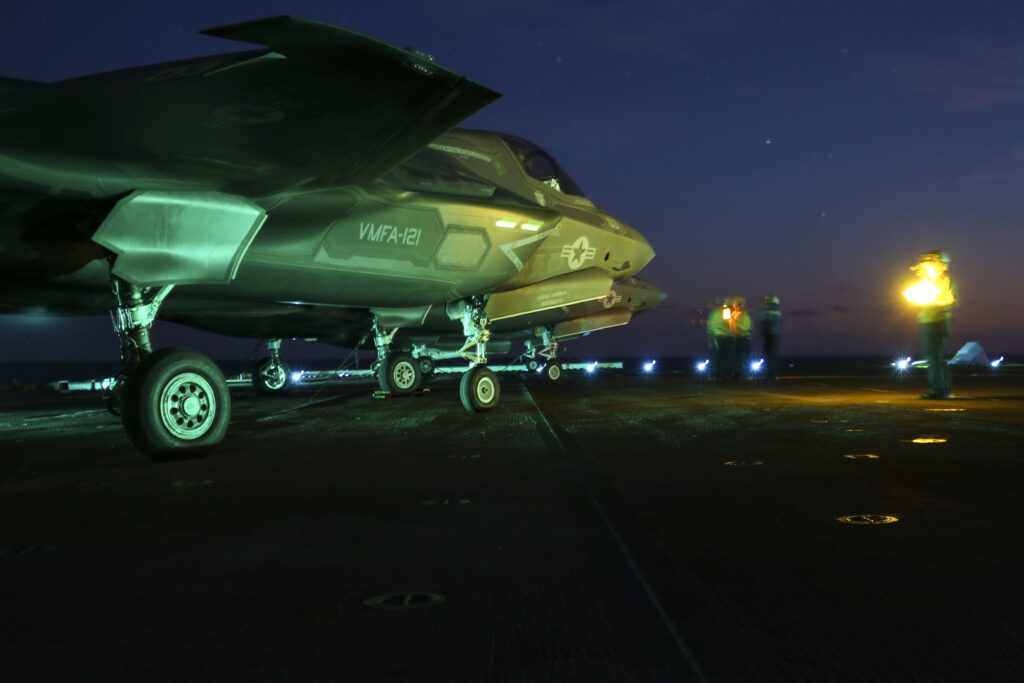ABOARD USS WASP: When you start getting bored during an operational test after watching the seventh or eighth F-35B float down the carrier deck and slip up into the air, you know the Marines and Navy are doing something right — or being very lucky.
The six pilots have put their planes into the air close to 100 times since Operational Test 1 (OT-1) began May 18. I was out on the USS Wasp all day yesterday.
Much of what the Marines are doing is focused on operations, in keeping with their plan to declare the F-35B ready for Initial Operating Capability (IOC) in July. Today, the F-35Bs are flying simulated operations to protect the Wasp from incoming enemy aircraft played by other F-35s. They’re trying to begin the process of generating sorties at the same pace they might have to during a war. (We heard from one pilot that the F-35Bs had already met and beaten the ship boarding rate of the Harrier fleet.) The Marines also flew the largest engine module out to the Wasp on a V-22 to ensure it would fit on the Osprey and to begin planning how to store the gear.

The biggest engine module of five that make up the F135 engine for the F-35B. It’s stored on the USS Wasp.
The 91 maintainers aboard the Wasp jacked up an F-35B and found they needed to come up with some new gear to do it easily and safely to manage the 32,300 pound aircraft.
But there is one aspect of the plane’s operation that raised concerns. “I’m most worried about noise” the aircraft generates, the head of NavSea (Naval Sea Systems Command), Vice Adm. William Hilarides, told me just before we left the Wasp. Earlier, a small group of reporters were interviewing F-35 maintainers in the hangar deck where the massive elevator raises and lower planes to and from the flight deck. An F-35B hovered and then landed, almost overhead. Everyone covered their ears. All conversation stopped. My head was ringing from the noise by the time the plane landed. The USS Wasp has placed microphones all around the flight deck, in the hangar deck and anywhere else that might be affected to monitor noise levels. Of course, noise is something the military is pretty effective at dealing with.
A gaggle of pilots spoke to us about the Marine’s version of the Joint Strike Fighter. There were two British officers on the panel as well, demonstrating the incredibly close working relationship between the US and British forces. After all, the biggest ship ever built for the Royal Navy, the HMS Queen Elizabeth, will routinely carry a dozen F-35Bs. We didn’t hear much news from the pilots, but the enthusiasm for the F-35 from former F-18 and Harrier pilots was impressive.
Perhaps the most interesting tidbit we heard came from a maintainer on the ship, Staff Sgt. William Sullivan. He’s responsible for ensuring the aircraft maintain their stealth signature. Stealth, of course, depends on coatings as well as engineering. Nicks, scratches or unexpected reactions with sea water and all the chemicals aboard ship could degrade the F-35’s stealth. So I asked Sullivan how the marine environment was affecting this: “Up to now the coatings have held up extremely well.”
Perhaps the most surprising thing we heard was that ALIS (the Autonomic Logistics Information System) “is performing extremely well.” Lt. Commander Beth Kitchen of the Royal Navy should know: She’s stationed in Beaufort, S.C. with the Marines training to fly the F-35B and she is responsible for the UK’s efforts to build a maintenance force for their F-35Bs. Breaking D readers will remember that the head of the Joint Program Office, Lt. Gen. Chris Bogdan, has criticized the performance of ALIS and it remains one of his main areas of focus as the Marines approach IOC in July, to be followed by the Air Force in August next year.
Navy jet trainer fleet operations remain paused after engine mishap
One week after the incident, a Navy spokesperson says the service is continuing to assess the fleet’s ability to safely resume flight.



























